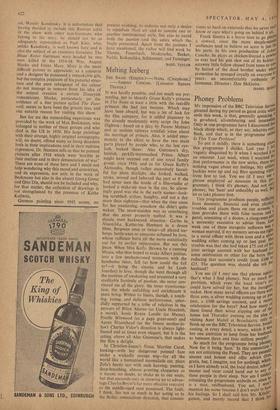Contemporary Arts
German Art at the Tate
HERE, for the majority to whom modern German art means little more than the words expressionism and Bauhaus, and reproductions of Franz Marc's horses, is perhaps the most educative exhibition since the war. Dr. Alfred Hentzen, of the Hamburg Kunsthalle, who has organised this survey, is, of course, right to remind us of the despotic control which Paris has had over our taste and knowledge in the past hundred years, and I have found it difficult to look at this show without a rooted preference for the French version of impres- sionism or the Fauve use of pure, non- descriptive colour, not to see recent German abstract painting in the context of a Manessier, say, or the Americans. And it is a measure of the ignorance to which most English critics must admit that we really cannot say whether the five galleries at the Tate do justice to the forty-two artists from Adolf Menzel to Fritz Werner who are on view.
Take first the general development of German art in the past hundred years. In France the passage from Corot to Cubism was certainly marked by moments of radical change, but somehow these do not assume the character of absolute revolt and independence. In Germany, however, the founding of the Brticke group at Dresden in 1905 marks, it would seem, an extraordinary gesture of defiance, and it is perhaps a pity that the hanging of this exhibition did not allow opportunity to move directly from the world of Menzel and Marees, of Liehcrmann and Corinth into the vortex created by Kirchner. Heckel and Schmitt-Rottluff. German art of the nineteenth century has an oppressive, a
Victorian solemnity which, however high- minded or idealistic, is also gemiitlich. Frankly, the painters of thiS time do not compare with their French contemporaries, but they do provide some interesting comparison with English painting. Hans Marees is a far more capable, eloquent and painterly rhetorician than Watts, even if his particular mythology is no more acceptable. Leibel in his Pre- Raphaclitc—or should it be his Holbein manner?—is a far more searching and subtle naturalist painter than any in our nineteen1h- century history. Liebermann and Slevogt remind one at moments of the English brand of impressionism practised by a Sargent, a Steer'or a MacEvoy, but their vision and their talents are more serious and considerable. And then, with the arrival of the Bracke generation, comes not a period of transition, such as our Camden Town artists represent, but a violent repudiation of sombre reserve or reasonable impressionism. The Bracke painters combine a Fauve-like intensity of colour with a primi- tive and angular method of drawing, and although the painters concerned emerge with notably distinct personalities it is the linear distortions and simplifications in face or figure which seem not only dated but truly unsatisfy- ing. It is this and not the colour or the paint which creates a mood of doctrinaire defiance. By comparison, the artists of the Blaue Reiter, which was emerging in Munich at the same time, who held their first exhibition in 1911, seem, .in spite of their cubist and abstract tendencies, almost conservative. This move- ment was led by one of the greatest intel- ligences and teachers in twentieth-century art, Wassily Kandinsky. It is unfortunate that having decided to include this Russian artist in the show with other non-Germans who belong to the story. he should not be as adequately represented as Paul Klee. who, unlike Kandinsky, is well known here and is also the subject of an extensive literature. The Matte Reiter Germans were headed by two men killed in the 1914-18 War, August Macke and Franz Marc. Marc is the more difficult painter to appreciate; as a colourist and a designer he possessed a remarkable gift, but the complex precision of his pictorial struc- ture and the pure refulgence of his colour do not manage to remove from his idea of the animal creation a certain Disneyish romanticism. Macke, particularly on the evidence of a fine picture called The Fare- well, seems to have been the greater loss, and one notable reason for visiting this show. But for me the outstanding experience was provided by the work of Max Beckmann, who belonged to neither of these groups and who died in the US in 1950. His large paintings with their strange, highly original iconography will, no doubt, offend many as being decadent both in their implications and in their ruthless expression. Dr. Hentzen tells us that he painted pictures after 1918 which were 'terrible in their realism and in their denunciation of war.' There arc none of these here and I could not help wondering why this mood and conviction, and its expression, not only in the work of Beckmann but also in the absent Georg Grosz and Otto Dix, should not be included and why, for that matter, the collection of drawings is not strengthened by the presence of Kathe Kollwitz,
German painting since 1945 seems, on present evidence, to indicate not only a desire to repudiate Nazi art and to assume one or another internajional style, but also to avoid both the passion and the satire, which the Nazis persecuted. Apart from the painters I have mentioned, the visitor will find work by Thoma, Feuerbach, Modersohn, Becker, Nolde, Kokoschka, Schlemmer, and Feininger.
BWL. TAYLOR











































 Previous page
Previous page